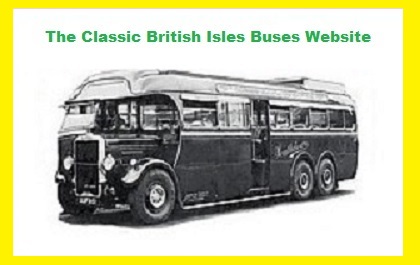

The Classic British Isles Buses Website
Classic buses in Australia, page 3 (by Dick Gilbert)
Last updated 27 August 2024
Email Events diary Past events list Classified adverts Classic U.K. Buses Classic Irish Buses Classic Manx Buses
| Page 1 | Page 2 | Page 3 | Leyland OPS4 Tigers |
These pages form a scrapbook of material about British buses in Australia.
Please feel free to send any suitable items and I will be happy to post them.
ANOTHER LEYLAND MOTORHOME
And here's another Sydney Leyland Titan. Mal Howell asked "Can you please help me i/d this bus I just purchased? I think it's a Leyland. The engine no is Leyland C5207, Type E66/1N."
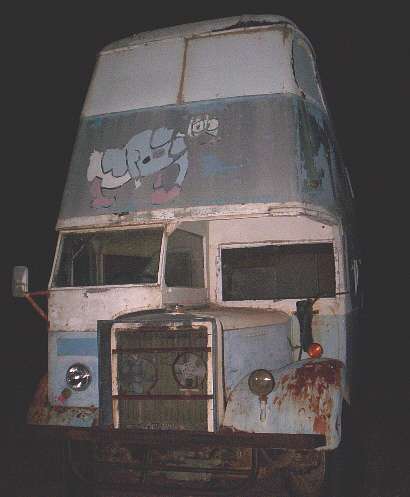
Again my guess is that it's a Sydney Leyland Titan OPD2, and once more we don't have a chassis number. Any ideas?
David Wilson says it's an OPD1 with a Clyde body, and quite rare!
NEWS FROM WHITEMAN PARK
It's always busy at the Bus Preservation Society of Western Australia facility, with a line of interesting projects waiting to be restored. One of their finest productions was completed in 2005, when Leyland LT1 Lion, ex Metro no. 22, was rolled out. Cameron Bell, President of BPSWA, very kindly sent me the photo below:

Built in 1929 it has a 4-cylinder petrol engine and a Western Australian built body. Owned and restored by BPSWA, the job was completed in July 2005, and it is seen here outside the workshop at the Bus Museum of Western Australia. Another picture sent by Cameron is below, and shows a Guy Arab from the fleet of Western Australia Government Tramways:
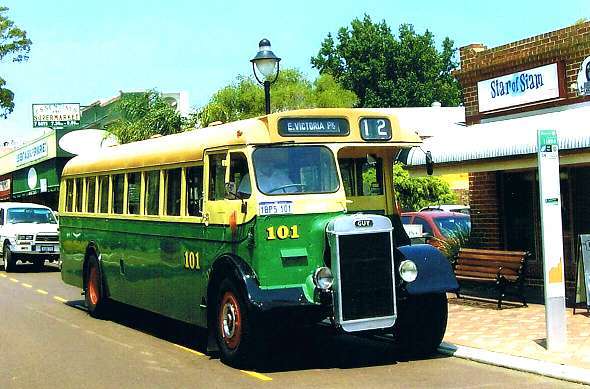
This 1950 Guy Arab III was no. 101 in the WAGT fleet (it was originally one of fifty), and has a 6-cylinder Gardner 6LW engine. Again this is owned and has been beautifully restored by BPSWA, and the work was completed in December 2004. These are two magnificent restorations, and a credit to the workmanship of the Society members. And there's more to come, judging by the stuff they have stashed away in the shed! Watch this space. Congratulations to the team, and many thanks to Cameron Bell for sending the photos.
REAL ANTIQUE DISCOVERED
Clay Atkinson from Queensland has acquired the remains of a 1936 Bristol bus which he hopes to restore.
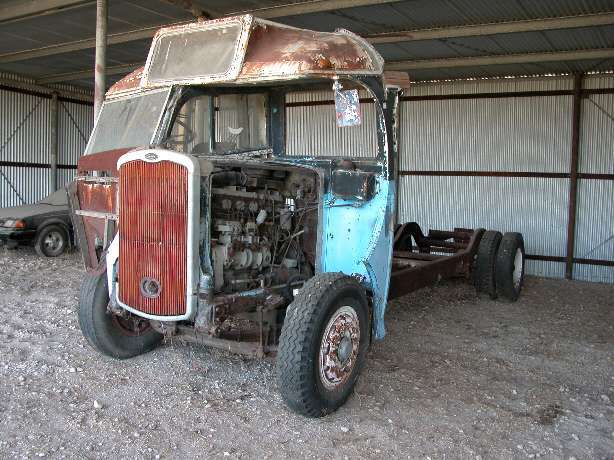
It's a Bristol JO5G originally delivered to United Automobile in north-east England as their fleet number BJO42 (reg number BHN 237). In the 1970s it was converted to a caravan and set off on a world tour.
In April 2006 Clay said "Looks like things are starting to come together to finally bring the Bristol home, I have a friend who believes he can borrow a truck and trailer for a weekend so we will go and pick it up ourselves. As you can see from the photo, the driver's cab looks quite unstable so I will be removing the windscreen and building some bracing in the cab area to support the roof during the trip. I will keep you posted on the progress."
In October 2006 Clay sent more info; "I thought I would let you know that I have finally got the Bristol back home to Brisbane. It was an interesting exercise, we organised with a local farmer at the pickup point to give us a hand, with his tractor to load it. He was very concerned initially that his machine would not be powerful enough to do the job, but once we got it rolling, steering and stopping, he soon got into the spirit of the occasion. All in all it only took an hour and a half to come up with a plan and get it on the truck, luckily there was a loading ramp that we were able to use which was great."
"Getting it off at home was another thing, we had no loading ramp and very little flat ground so we ran the truck up a reasonably steep embankment and lowered it off using a pair of 7 foot ramps, a snatch block and the winch on my Nissan Patrol. It was a slow and challenging task and took about 5 hours. Now for the hard bit, getting started on the restoration! Keep you posted." Thanks Clay, and good luck with the restoration.
And then, in February 2018 I received this from Bernard Cleary in the UK: "Please can you tell me if any progress has been made on the restoration of BHN 237? My interest is that I was the person who brought the bus to Australia in 1971. I could be travelling to Australia in the coming year and would be interested to see what has happened to it." So I sent a request to Clay for updated information, but my email address for him was 12 years out of date and didn't work. Subsequently I've tracked him down to Brendale, Queensland and I'm continuing to try to make contact. If anyone can help, please let me know! Meanwhile I will post all news and progress on this page as it happens.
A COUPLE OF LODEKKAS
Scott Mitchell sent me these two pictures of Lodekkas in Australia:
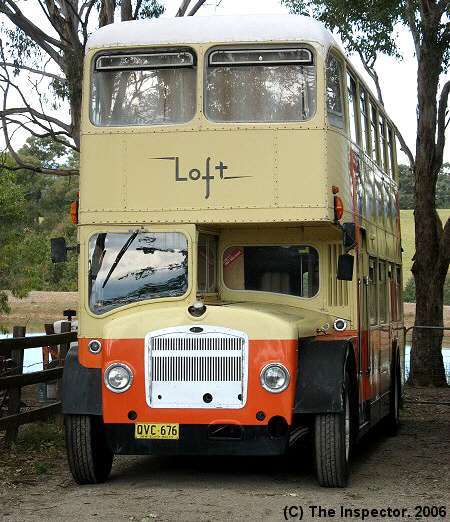
He says; "Here are two Bristol Lodekkas currently in NSW. The first one is a motor home and in Flight Centre livery, it is ex Top Deck Travel". This is LWC 665C, a 1965 FLF6G originally no. 2839 with Eastern National, joining the Top Deck fleet in 1983 as Loft. Now registered QVC 676 it was last recorded with Bill James of Sydney.
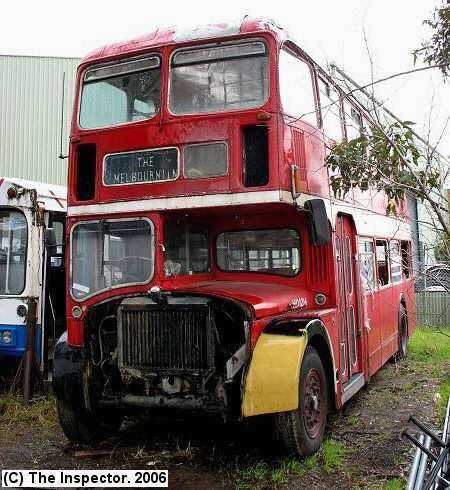
"The second one is ex Hants and Dorset no. 1517 (registration CLJ 868C). It spent time operating a sightseeing service in Melbourne, but that operation no longer exists. It now resides in NSW and is owned privately by a bus driver at Premier Nowra who intends on restoring it."
Thanks for the pictures, Scott.
THE BIG BLUE BEDFORD - A LITTLE STORY THAT GREW AND GREW.....
It all started with this, around the year 2000:
Ross Daniel wrote; "Gidday, have just stumbled on your site and I'm finding it very interesting. I thought you might be interested in some images of a Bedford bus we owned up until 1988. Not sure of its date of birth but think it was around 1950."
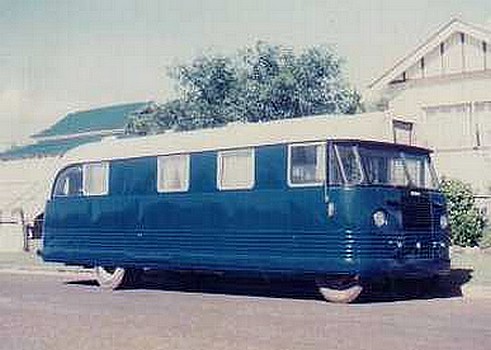
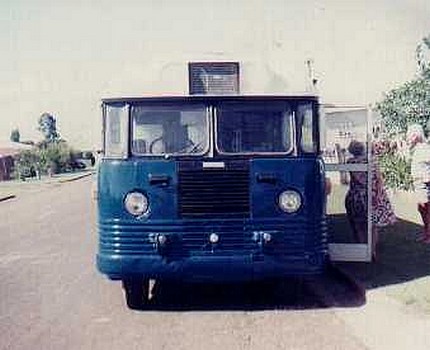
"We found it languishing in the back of a caravan park with no motor or gearbox, totally stripped out and in a dilapidated state. The park owner was glad to be rid of it, as he had no idea whose the bus was. It had been at the back of the park for many years prior to his buying it. My wife and I then spent two years rebuilding it as a mobile home. Unfortunately due to health problems we never actually got to use it, apart from a couple of small trips. I sold it and it is now being used as an office for a canoe hire company. As the bug to travel in a bus never left us, last year we bought a 1969 ex Sydney Leyland Leopard and are just setting everything up now. Anyway mate, loved your site and will drop back often. Cheers, Ross Daniel."
Ross later added the following; "Gidday Dick, I'm in the process of trying to track the bus down. When I find it I'll let you know. It was being used about 20 miles from here, Maryborough, Queensland, on the Burrum River, as a clubhouse for a canoe club. I'm fairly sure I can locate it. Also, I have some other photos I'll dig out and send to you if you're interested. About the only history I am aware of is that it was a council bus for the Redcliffe City Council, near Brisbane, and was originally painted red and cream. I was also told that these buses were built by the CAC (Commonwealth Aircraft Corporation) in either Adelaide or Melbourne after the 2nd World War on surplus Bedford 5 ton truck chassis, apparently to keep workers employed after the need for aircraft dried up after the war. Not 100% sure of any of this but I guess it could be checked somehow. Anyway mate, glad you liked the photos, I certainly agree that it is very important we record and disseminate this sort of information. Cheers, Ross."
Thanks very much for that Ross, it sure is an unusual beastie ! Anybody know anything more about these buses?
In response to the above I received the following from Ian Lynas; "The blue Bedford that Ross bought as a caravan did not come from Redcliffe City Council. They have never operated public transport. Bus services in Redcliffe (north of Brisbane) have been in the hands of two private operators, Redcliffe-Petrie Bus Service and Hornibrook Highway Bus Service. The former became Redcliffe-Brisbane Motor Services with heavy Worldmasters, Leopards, Royal Tiger Cubs, and the latter became Hornibrook Bus Lines in 1977. Hornibrook then took over Redcliffe-Brisbane."
"The Hornibrook fleet consisted of some of this type of Bedford (both OB and SB) purchased in the early post-war period. They had all gone by 1962. Yes, the bodywork was built in Melbourne by Commonwealth Aircraft Corporation, over 1000 were built. Hornibrook's fleet was a couple of Bedford SBs, loads of Worldmasters, Leopards, Tiger Cubs, Royal Tiger Cubs and Japanese Hinos. Hornibrook are still in business as Hornibrook Bus Lines with a big fleet of Mercedes-Benz 0305, 0405, OH1625 and a couple of minibuses. They also have on lease 11 Volvo B10M's from Brisbane City Council." Thanks Ian.
In April 2006 I received this:
"Hello from Perth, I just thought that you might like to know that, seeing the blue bus, and owning as I do, a Comair bodied SB, I have to say I think it's a Holden body. Our state library has a 1940s sales book for the SB and the drawing is of the streamliner type body which it clearly states is Holden. It certainly is quite unlike any Comair. Sorry to chuck a cat among the pigeons but I do like your site. Cheers. Michael Mullany, nr. Perth"
In July 2006, David Hurst of Korumburra, Victoria called with information from his father, Ian Hurst: "Regarding the Big Blue Bedford, Dad had this to say: 'It is an OB Bedford - O designates Bedford O series, and B designates Bus chassis. It appears to be a 31-33 passenger CAC-bodied vehicle. Would be keen to know the door configuration on the left side which would make definite identification easier. All CAC bodied OB series buses had the front mudguards enclosed, when they weren't rattling open!'
'CAC bodies were built in the Commonwealth Aircraft Corporation factory at Fishermans Bend, Melbourne, Vic. between 1946/7 and 1952. This vehicle appears to be c.1950, but without knowing the door configuration makes i/d a little difficult. The CAC bodies were manufactured similar to aircraft construction, with an aluminum skin that was solid riveted to a formed rib frame. On the shocking roads of the time, rivets wore loose, occupying the country bus proprietor's time immensely, replacing rivets. OB chassis vehicles were grossly underpowered, underbraked and the 4 speed full crash gearbox needed constant driver concentration to promote smooth gear changing. CAC later renamed their bus bodies as Comair.'
"My Grandfather pioneered government subsidised school bus travel in country Victoria many years ago. Ralph Hurst began transporting children from farms to the Korumburra Higher Elementary School in a 7-seater Vauxhall car, converted to carry 14 children. The Vauxhall was the ex governor's car I believe. Ralph's fleet grew over the years, his sons Brian and Ian (my father) also joined the business. Ralph passed away in 1968, leaving the fleet with both sons. Ian retired due to ill health in the mid 1970s, Brian continued and later his son Trevor joined the business. Over the years Hurst's of Korumburra was scaled down to two buses, and Brian retired from driving. Trevor sold off the remaining bus circa 2000. The bus service continues with other owners, namely Harley's of Korumburra. Also my Mother's brother has a fleet of buses on school runs, Alan Winterhalter. My Dad taught him to drive buses. Sadly Uncle Brian passed away in 2003."
"I have attached a couple of photos for you."
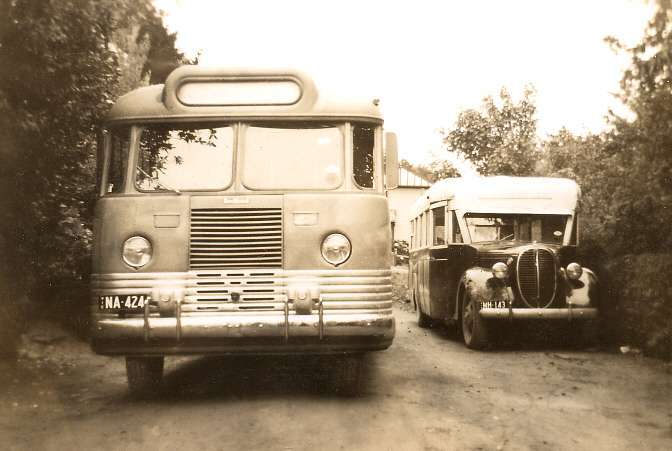
"First is NA-424, a 1949 Bedford OB on its delivery day to R. R. Hurst and Sons. Beside her is the fourth bus purchased by Ralph Hurst, an ex McHarry's of Geelong 30-seater Ford, MH-143."
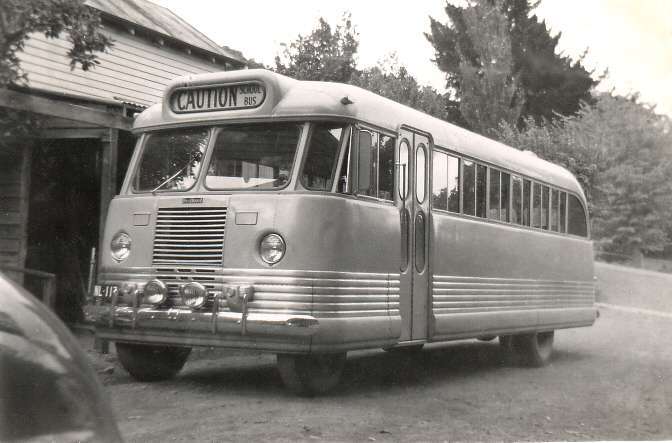
"The second image is Nelly (NL-117), a 1950 Bedford OB, also on its delivery day to R. R. Hurst and Sons."
My thanks to David for the pictures and details.
In 1988 Pete Kane photographed MO-3712 in 1988 at the Bi-Centennial Rally. It wears the livery of Purtill's bus service, based in Deniliquin, New South Wales. Keith Purtill started operations in 1951, and the firm now have the honour of operating what is thought to be the last Bedford OB still in service in Australia, and this is it.
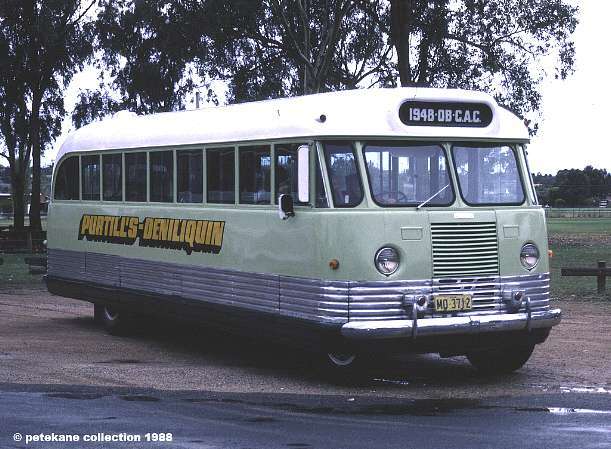
As Purtill's fleet number 9, it is a 1948 CAC-bodied Bedford OB preserved as a school bus. They acquired it from Rose, Conargo, NSW, but it had previously been with another (unknown) operator in Rochester, Victoria. Anyway it's clearly yet another one of the same breed as the others. Pete says "The Bi-Centennial Rally was held in 1988 when the Victorian BCSV decided to run some restored buses from Melbourne to Sydney for the official opening of the HCVA museum. There were about 6 vehicles made the journey and we went via Deniliquin, where the OB joined the rally." Thanks for that info Pete, and also for letting me use the photo.
And then in October 2010 the Bus Preservation Society of Western Australia of Whiteman Park, Perth acquired one. Here it is outside their depot on 10 Oct 2010 shortly after its arrival.
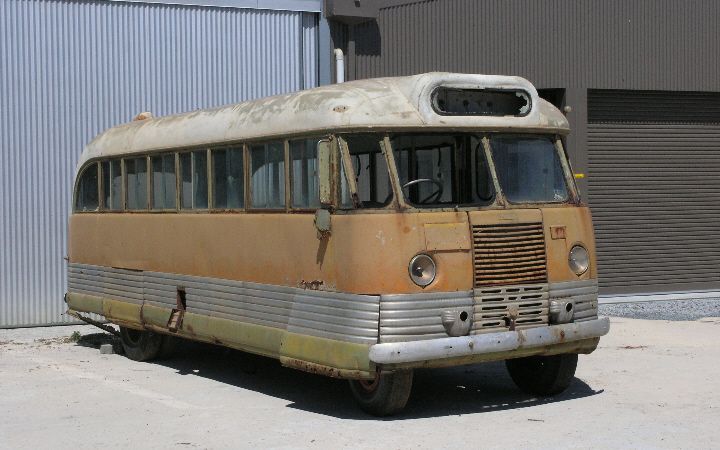
The Society's newsletter Rattler says; a 27-seater Bedford OB that has been languishing on a property in the north eastern wheat belt was promised to our Society several years ago. We decided it was time to retrieve it from its dry storage and repatriate it to Whiteman Park. Its history is unknown, and it is thought it was used as a school bus all its life. Bedford OBs were operated by many private bus companies in Perth, including Beam, Emu, and Tourist Omnibus Service - fleets that are not represented in our collection, so there is potential to repaint our delightful little OB into the livery of one of those long lost fleets. The bus is in remarkably good condition for its age, and still has quite a few difficult-to-replace fittings and items. It doesn't appear to have ever been fitted with flashing turn signal indicators, suggesting a life in the country and withdrawal from use many years ago. Nor has it been subjected to a motorhome conversion."
Many thanks to Colin Davison and Cameron Bell for the news, and to Nicholas Pusenjak for the photo.
And here come some more.
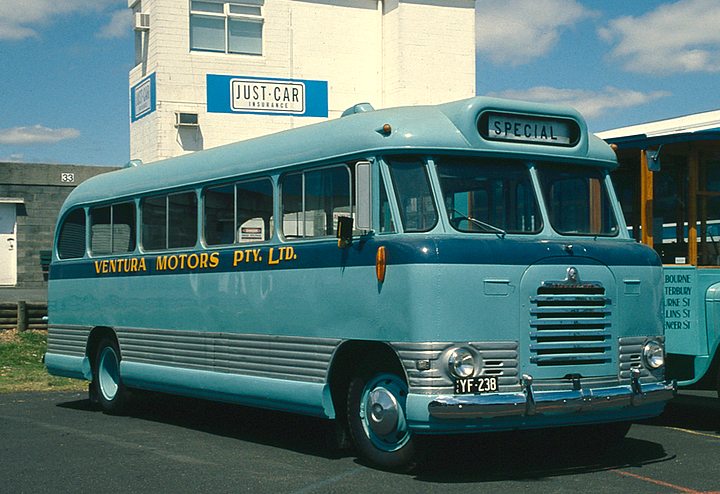
Peter Kane has very kindly let me reproduce some more of his fine photos, this one showing Bedford YF 238 seen at the BCSV Sandown Rally in 2007. This restored route service bus wears the livery of Ventura Motors, and has a similar style of CAC body, although this example is a 1951 Bedford SB3 and not an OB.
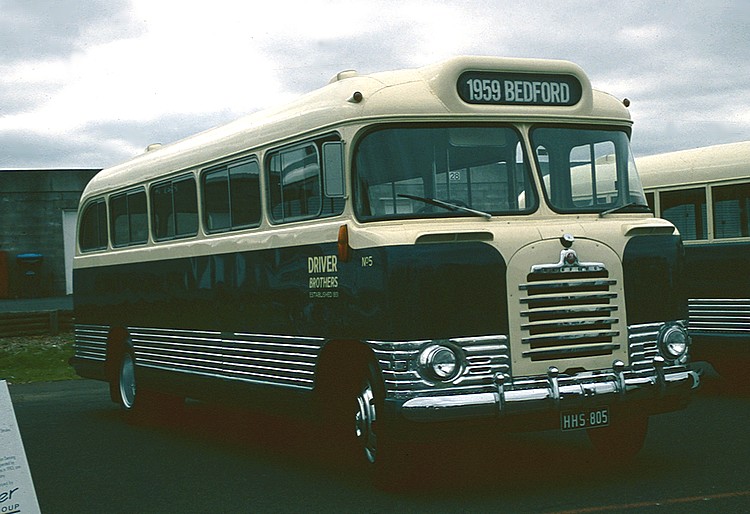
Also at the Sandown Rally in 2007, this is no. 5 from the Driver Brothers preserved fleet. HHS 805 is a Comair-bodied Bedford SB3, previously a Melbourne route bus.
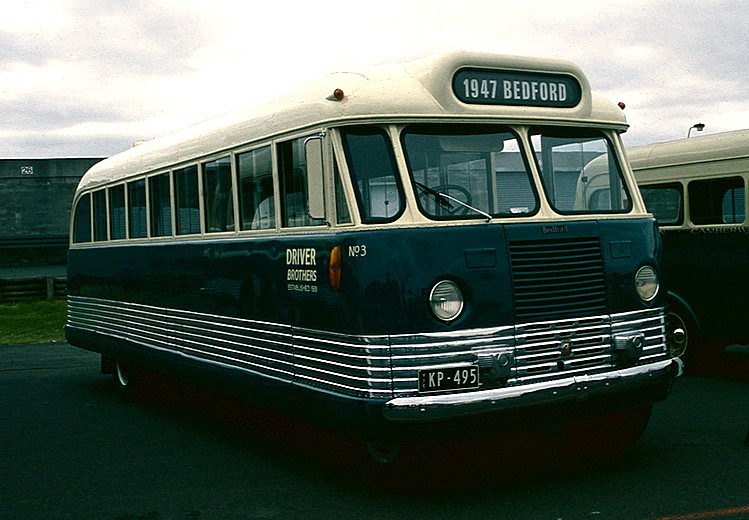
And at the same rally, this is Driver Brothers no. 3 (KP-495), another ex Melbourne route service bus, but this time a 1947 Bedford OB (chassis number OB 81181) with a CAC body. Thanks again to Peter for the photos.
In 2020 Ian Lynas sent me comprehensive information about these vehicles: "Regarding the CAC (Commonwealth Aircraft Corporation) Bedford OB in blue livery, there was a note that the body was built by Holdens, the now extinct car-maker. Holdens did make bus bodies, almost all for South Australian bus operators in the pre-war years. In 1946 the Australian Government set up a car factory in the Adelaide suburb of Lonsdale in a joint effort with General Motors and Holdens were taken over as part of this deal, the company becoming General Motors Holden (GMH) in order to build cars. In 1948 they began to build bus bodies using aircraft building technology at the Commonwealth Aircraft Corporation plant at Fishermans Bend in Melbourne. Now of course GM was the parent company of Bedford and GMH became the main Bedford dealer in Australia.
They bodied over 300 Bedford OBs of various sizes - enthusiasts nicknamed them bathtubs because they looked like upturned bathtubs, with flaps over all wheel arches. The badge inside always had a GMH paint number and this is where a lot of people make the claim that they were built by Holden. The Commonwealth Aircraft Corporation went on in 1951 to body Bedford SBs and over 1,300 were bodied using three styles, the flat screen, the wrapround and the shark front. In 1959 Commonwealth Aircraft Corporation did a deal with the Bus Proprietors Association of Victoria to rename the bus-building section to COMAIR (an abbreviation of Commonwealth Aircraft) and Comair would be a marketing and design organisation. Then bodies began to appear with Comair on the front and this led to 1,500 Bedford SBs, almost 300 Bedford VAMs, YRTs, 26 bodies on Leyland Leopard and Royal Tiger Cub chassis, Albion Viking VK57, a Ford and four made up bitsas incorporating Albion Clydesdale chassis and running units, then a huge order of MAN SL200s for Canberra - and ten for private operators, plus bodies on Volvo B58 chassis mainly for the MTT Tasmania. That's the total production into the early 1980s." Wow - thanks Ian. I think that tells the whole story!
ANTIQUE LEYLAND LION NOW IN GOOD HANDS
Bob Pearce called me some years ago from Perth WA to say he had acquired a 1935 Leyland Lion LT5A halfcab which he intended to restore. The bus was first registered in 1935 in Perth, and became no. 36 in the Metro fleet. The 32-seat bus body was by local makers Campbell and Mannix.
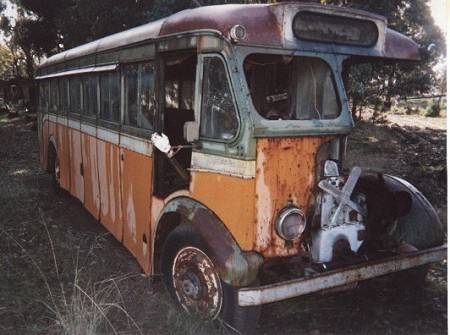 /font>
/font>
Note the original hand signalling device beside the mirror!
Bob told me that the bus was sold by Metro in the early 1960s to the lower south-west of W. A. for use as a school bus. It was last licensed in 1965, and Bob kept it some 400 kms southwest of Perth. It was basically complete, although much work needed to be done to get it working again. The present motor is a 4-cylinder diesel, type E.101, and the engine number is 10.933. Bore is 4.5" (the plate reads 41 but it is not distinct - so it is a guess that it is 4.5"); stroke 5.5"; rating 32.4HP; Firing Order 1 3 4 2.
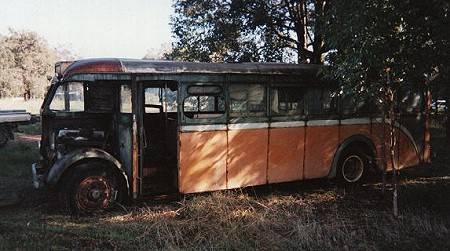
But the story doesn't end there, because in 2006 the Lion was donated to the Bus Preservation Society of Western Australia, based at Whiteman Park. Cameron Bell from BPSWA very kindly sent me the photo below showing the bus at Whiteman Park, and it now joins the list of vehicles waiting there for a new lease of life (some fantastic rebuilds come out of that facility, so it couldn't be in a better place). Many thanks to Cameron for the photo. Looks like a lot of work to do!
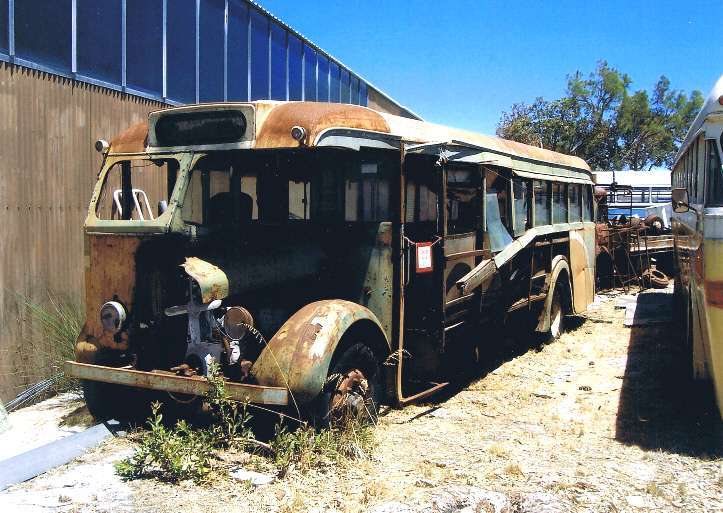
ANCIENT TITAN DOWN THE MURRAY RIVER
Steve Aitkenhead sent this photo of a bus (converted to living accommodation) that he took in 2004 while on a houseboat holiday on the Murray River, downstream from Mildura.
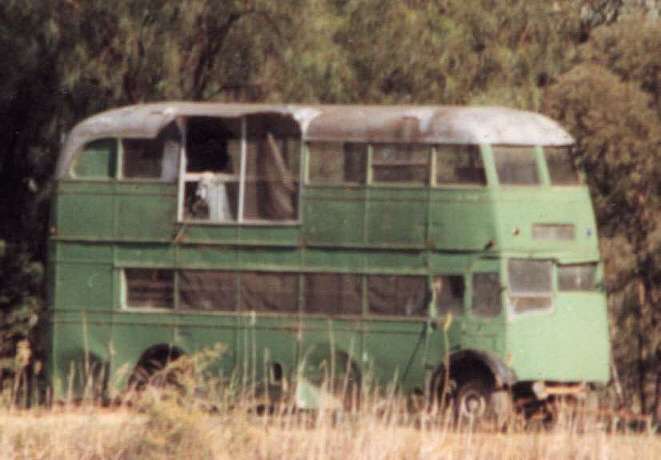
Thanks to Dave Urquhart and others, we are pretty sure it's a Melbourne and Metropolitan Tramways Board (M and MTB) Leyland Titan TD5c from around 1940. Peter Guttridge wrotes "Yes it is a Melbourne Titan even though the front has been panelled to look like a trolleybus. I saw another one, also in use as a caravan, in Mt. Gambier in 1960."
It seems some were bodied by Leyland, and some bodied locally in the same style. I wonder exactly which one this is? Are there any other survivors, or is this unique? (Actually I now think here are at least five in existence.)
And that's exactly what David Wilson did - he tells me: "the bus on the website is ex MMTB 222 which had previously been in use by Wentworth Shire Council as a workman's van. It was stripped of its motor about 30 years ago and sold by the Council. Others survive - 211 at St Arnaud VIC (with engine), 245 at Colleambally NSW, while 207 and 226 are preserved in VIC, but not restored. They are now extremely rare buses."
Thanks David. Meanwhile John Dixon kindly sent me some more background info: "A little bit of additional information for you. They were used as replacements for the cable tramway in Bourke Street, Melbourne (North Fitzroy and East Preston routes) which were, in turn, ousted by electric trams by 1956. There were 45, fleet nos 201-245 and matching registration numbers of AT 201-245."
"Bodywork was by Cheetham and Borwick (201-230, 241, 242), Lawton (231-240); Martin and King (243, 244); and Leyland (245). 245 was H30/26R the remainder H30/24R. So examples of three bodybuilders survive. All were withdrawn by Jan 1954." Thank you John.
1950 W.A.G.T. TIGER TURNS UP
Rob Smith from Kalgoorlie sent me this picture of a mobile caravan he has bought;

We've identified it as one of four OPS4 Tigers bought new in 1950 by Western Australia Government Tramways (WAGT). Will Plumridge has very kindly sent much background information, so here's the story. WAGT introduced the four Tigers in December 1950, numbered 78 to 81 (rego 10.803, 10.802, 10.805, 10.807, and c/n 483912, 491907, 491906 and 491904 respectively). They all subsequently passed to MTT, who substantially rebuilt the original ComEng B42FR bodies to B45F in 1965-67, and renumbered them as 359-362.
Rob's bus is No.360, and No.361 now apparently survives at the Bus Museum of Western Australia, Whiteman Park. Thanks to Rob for telling us about it and sending the picture.
BRITISH BUSES IN WESTERN AUSTRALIA
I was sent these images by Nicholas Pusenjak from Perth, Western Australia. Nicholas is a founder member of the Bus Museum of Western Australia, and more of his pictures can be found on the other Australian pages. This time he has sent the following:
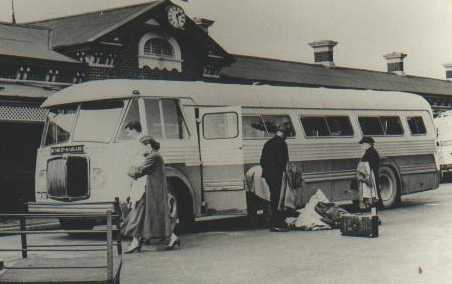
"Western Australian Government Railways AEC Regal III at Bunbury railway station in the late 1950s. This bus was rebodied in the mid to late 50s."
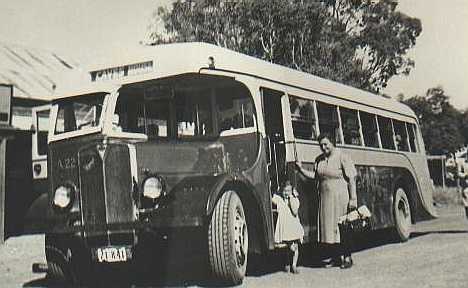
"W. A.G. R. AEC Regal III no. A22. This was the original appearance of the WAGR Regals which were later rebodied as per the first photo above. They were used on country services and the poor state of our rural roads in the late 1940s and 1950s literally caused the wooden framed bodies to shake to pieces. Also, in an era of increasing car ownership, their dated appearance wasn't conducive to attracting passengers and there were no funds for new vehicles, hence the rebodying programme."
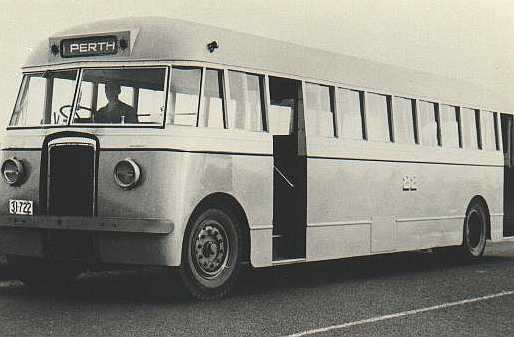
"W. A. G. T. Daimler CVG6 no. 22 when new. This had a body by Charles Hope of Queensland. I have included this shot to show how many of the vertically engined chassis were bodied in Australia. The Daimlers had exposed radiators, whereas many full fronts had a tin grille."
Thanks again Nicholas for some great pictures.
Postscript: Sadly Nick Pusenjak passed away suddenly in May 2017. He had been sending me photos and comments from Australia for years and was an amazing source of information about Australian buses and other old transport matters. His contributions can be found all over this website, and will remain there for ever as my tribute to a fine fellow who is sadly missed.
PRESERVED METRO BUSES LEYLAND TIGER no. 81
Colin Davison of the Bus Museum of Western Australia has kindly sent me this picture of the Museum's 1949 Leyland OPS4/1.
He tells me it has a 40-seat front-door body built by Boltons Pty Ltd of West Perth to a design by Sydney based Commonwealth Engineering. It was new to Metro Buses, the biggest of the private fleets in Perth, entering service from 19 October 1949 registered 31.981. It saw service on the busy Perth - Fremantle services, and on the interurban Fremantle - Rockingham route.
From 31 August 1958 (by which time it had been re-registered 45.681), it passed to the newly formed Metropolitan (Perth) Passenger Transport Trust, more commonly referred to as the MTT. It saw regular service, latterly from the Armadale depot and with two further registrations, until withdrawal on 19 May 1972, following which it passed to the Bus Museum's predecessor organisation for preservation.
It has now spent a longer time in preservation than it did in service, but is one of the easiest starting, sweetest running vehicles in their little fleet. It received some minor refurbishing and a full repaint in 1995, in connection with the launch that February of the trading name MetroBus for the heavily revamped MTT. Colin says that the shade of green around the windows is not quite right, despite their efforts to find the right one.
The photo was taken in October 1997 at Whiteman Park, where the Museum is based. Thank you very much Colin for the photo and the information. Anybody in the Perth area should definitely pay the Museum a visit.
PRE-WAR LONDON T FOUND IN AUSTRALIA
In 1997 AEC Regal T499 (Green Line 10T10 class) was discovered on a farm near Perth. Here, specially written for this website, is the story from Ian Kerr.
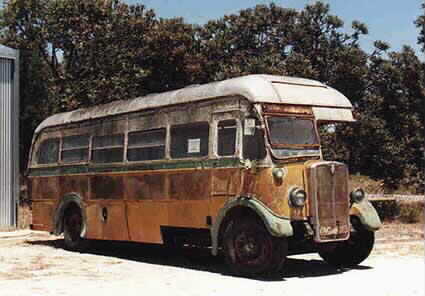
Photo: Colin Davison
"One of our retired members, who is also a member of a group who travel around the state giving tree seedlings to farmers in an effort to overcome soil degradation, came across this old bus on a farm about 370 kilometres south of Perth. He took a few photographs and reported the find at a Bus Museum meeting (at which I wasn't present). Apparently he talked the farmer into donating the bus to the museum but the committee declined the offer as it doesn't fit the aims of preserving buses of Western Australian heritage."
"Sometime later I heard about the find of this I think it's a T type, and decided the opportunity was too good to let pass. I went down to the farm with a friend (another pom who has this strange leaning towards buses of Birmingham Corporation origin) to have a look at the condition of the bus and decided to take it for myself. I always wanted my own bus and to be honest had already made up my mind to have it before going! My friend offered to go halves and, much as I would have liked to go it alone, with thoughts of the restoration costs involved, I accepted."
"The bus appeared to be remarkably intact considering its age, but was missing the two front wheels, the battery box panel and all the interior seats. Both destination boxes had also been removed and panelled over. It had been painted in a yellow and green livery at some stage, but the Australian sun had taken its toll of this, as it could be picked off in large chunks revealing a shiny aluminium beneath. I was able to identify the bus as T499 from the brass plate still attached to the dumb iron."
"Home again and I dug out all the information I could find on the 10T10 from my books. I even found a photograph of the actual bus (in Green Line 1930-1980, a London Country Publication) taken during the war when it was converted to an ambulance. I'm becoming an expert on all the detail differences of the 10T10! Why did some have that odd offside front mudguard?"
"A few weeks later, armed with a can of WD40, a tool box and a couple of spare wheels, saw the two of us back at the farm getting T499 ready for transporting back to Perth. One of the wheels was a spare from the Museum's Leyland trolleybus of the same vintage and looks very similar to the 10T10's originals. The other, the only other wheel we had available, was from a later model Leyland. This fouled the steering linkage and couldn't be tightened up, so we used one of the rear duals."
"Air was pumped into the flat rear tyres and then the moment of truth - would it move? A quick pull with a chain and tractor proved that someone had had the sense to park the bus with the handbrake off all those years ago!! The opportunity was taken on this second visit to have a closer look at the condition of the bus. The bodywork was not as sound as first thought, as most of the wood in the framework has rotted away, the beading strips being all that was holding the panels on in some places. The interior was full of junk on our first visit but had now been cleaned out and it appears that most of the trims are still fitted - some windows could even be wound up and down."
"The bus arrived at the Bus Museum's premises on Monday 24 November on a low loader. A couple of panels had come away from the body on the journey to Perth, including the two lower rear corners and the one under the rear emergency exit which came away completely as one unit. The bus is now waiting to be placed in a corner somewhere ready for work to start. But where to start??!!"
"The wife of the farmer where T499 was found managed to contact the wife of the original Australian owner (her husband died 6 years ago), and passed her phone number on to me. This lady has a son who lives in Perth and we have arranged to meet when she next comes up for a visit. She did tell me they bought the bus from North's in Leeds in 1954 to replace an old box on wheels they had at the time on their school bus run. They paid 250 pounds sterling for it, a further 500 Australian pounds to ship it out, plus 500 Australian pounds import duty. She and her husband had asked her father in England to send out a 7.7 litre engined bus, and that's what they thought they had until the engine failed. Only when the wrong parts arrived from England did they realise that T499 had an 8.8."
"Eventually, and this is the bit I find most disappointing since finding the bus, they changed the engine for a 7.7. She did say she would do a phone around to see if she can trace the original engine. More on the history at a later date."
"The next step now is to draw up a plan of restoration including parts required etc. I would be pleased to hear from anyone who may have drawing of the body we could copy or buy, especially of the destination boxes. As for the livery - it's too early days yet to decide what colour to restore it to. It doesn't appear to have been painted red as I can't find any traces of the colour on the body. I quite like the look of the early black and white shots of 10T10s in what looks like three tone green, as in the photo of the lineup of six of these buses when new in 1938 outside of Hemel Hempstead Garage."
"I would have much preferred finding an ex-Liverpool Corporation Orion bodied Regent V (well I think it's a classic!), or Weymann Regent III but I don't think that's likely - there again, who would have thought a 10T10 would turn up on a farm in the south west of Western Australia? I've always had a soft spot for London Transport products, especially the RT/RTL and RM, so how could I turn down the offer of such a rare find." My thanks to Ian for that news.
However the update now is that the vehicle was repatriated to the U. K. for restoration and display at the museum set up by Ensignbus in Purfleet. It arrived in December 2004, and the massive task of restoration got underway. Do visit their website for the latest pictures and news. Well done Ensignbus! In the meantime, here's a picture kindly sent by Scott Mitchell, who visited the Ensignbus works during 2006.
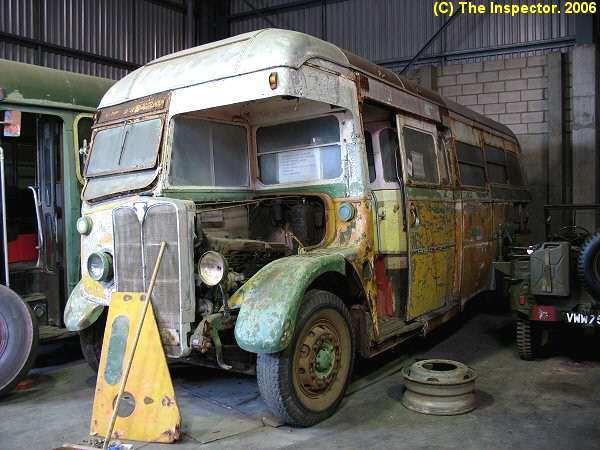
In 2019 Scott visited Ensignbus again. He said "Here's a photo showing how T499 looks after Ensign had restored her. I was lucky enough to be driven back to the nearby railway station in this bus after my depot visit."
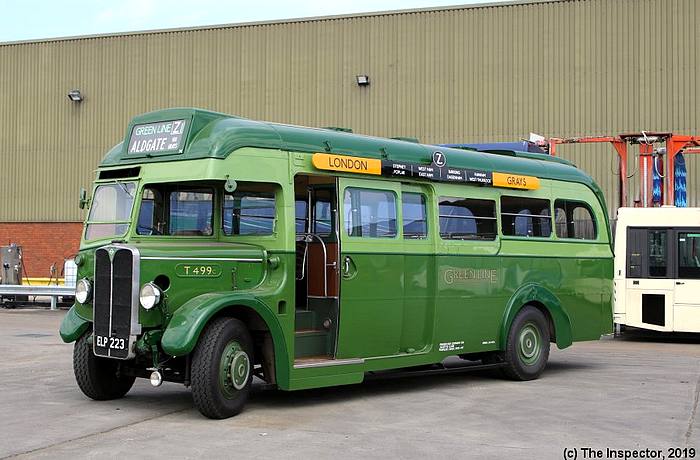
Thanks Scott, it looks terrific.
For more details of the 10T10 class, see Ian Smith's excellent page here.
BRITISH BUSES IN WESTERN AUSTRALIA
I was pleased to receive some mail from Nicholas Pusenjak in Perth, Western Australia. Nicholas is a founder member of the Bus Museum of Western Australia which has a very interesting collection. It includes several Leyland OPS4s, a Leyland Royal Tiger, a modern Leyland Lion and a Panther, and a Guy Arab III (see photo below).
Also in the museum is ex London Transport RTL 547 ( ** SEE NOTE AT THE FOOT OF THIS ITEM **) in full LT livery (not one of the RTLs I recorded seeing in my youth), and a Regal III. The Regal was delivered new to the Fremantle Municipal Tramways, an avid AEC user which ran Regals before the war, and ended up with a fleet of Regal IVs prior to their takeover by the Perth Metropolitan Transport Trust around 1958. Nicholas thinks that the Regal had already departed from the fleet by this time, but went instead to Kalgoorlie, the gold mining town some 375 miles to the east.
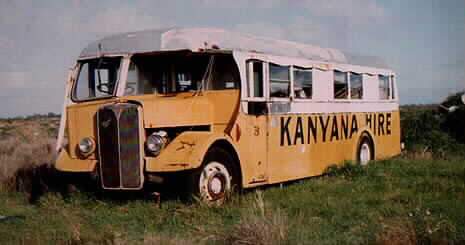
It had been converted to a caravan when acquired for preservation. The Museum managed to get it started some time ago, despite it not having run for many years and the wiring having been vandalised. Nevertheless, with a couple of batteries and some jury-wiring, the engine turned over half a turn, then fired on a couple of cylinders, and then within seconds was idling nicely with that lovely AEC beat.
In true form, the engine rocked gently on its mountings and the vibration was accompanied by the sounds of tinkling glass as broken windows fell from their frames. The air valves were missing from the compressor so they couldn't get air to the brakes or gears, and the radiator hose fitting to the engine was corroded away, so they couldn't run it for long. Subsequently, with a radiator and air, the bus appeared to run well. The body is a timber-frame half-cab, which Nicholas describes as quite English looking in some respects - well, nothing like the Regals in Montevideo. It has a front entrance with folding doors.
Here are some more images from Nicholas, the first of which is no. 515, an AEC Regal that had been rebodied in the mid 1960s.
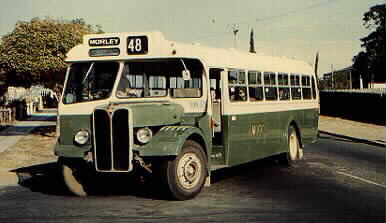
Below is a Leyland Tiger OPS4 (no.283) originally supplied to the Melbourne Metropolitan Tramways Board and sold to Western Australia in 1959. This bus is still around. For more details see my MTT webpage here.
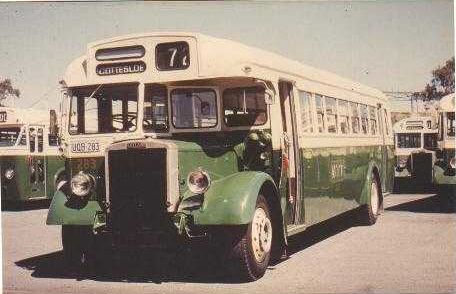
Next is Guy Arab III no. 328, one of 50 in service, taken around 1973. British enthusiasts would probably not have recognised it as a Guy at all!
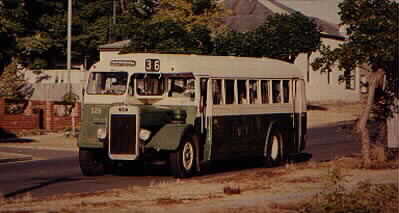
Lastly, we have another Guy Arab, no. 325, which is preserved at the Bus Museum of Western Australia. It was donated to the Museum by the local transport undertaking in 1974/75, and is a very appropriate exhibit as Perth used to have a large fleet of half-cab Guy Arabs.
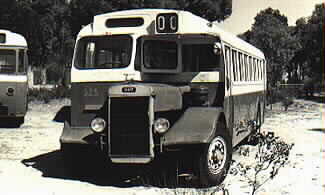
Nicholas says that progress with restoration has been very slow because there are only about 50 enthusiasts in Perth out of 1.5 million people. However the Guy is coming to the top of the list, and they hope it will be operational soon.
Many thanks to Nicholas for all this material.
** RTL 547 (KYY 640). In 2004 ex London Transport RTL547 (believed to be the only RTL in Australia) was sold by the Bus Museum of Western Australia, as it was felt that it did not fit their policy of preserving local vehicles, despite the fact that it had been in the area since 1969. There has been some discussion in enthusiast circles as to whether that was a good move or not, but in any case the bus has now transferred into the hands of a private owner in Sydney. When spotted later in the year it seemed to be in good condition and roadworthy. It is now registered TV-3147 and is available for private hire.
Thanks to Dave Urquhart for this update, and thanks also to Derek Cheng for permission to use his photo (below) of RTL 547 taken at the Tempe Bus and Truck Museum on 5 December 2004.
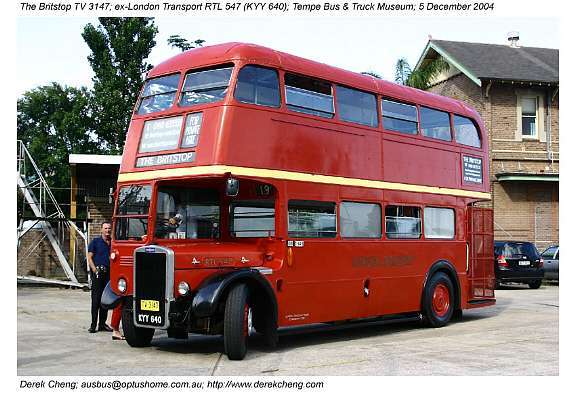
Scott Mitchell sent me another picture of this bus in 2017, by which time its condition had deteriorated. See this page.
Email Events diary Past events list Classified adverts Classic U.K. Buses Classic Irish Buses Classic Manx Buses